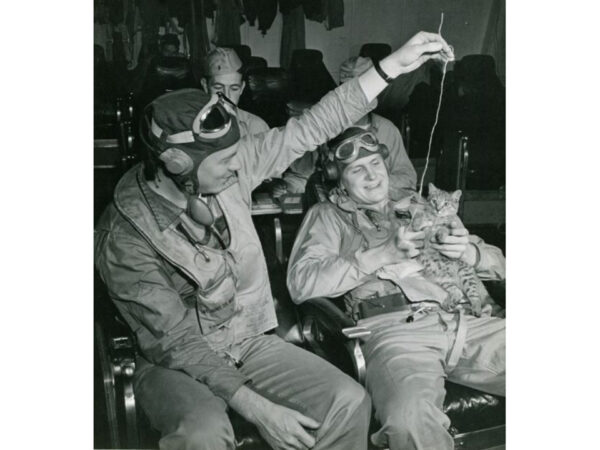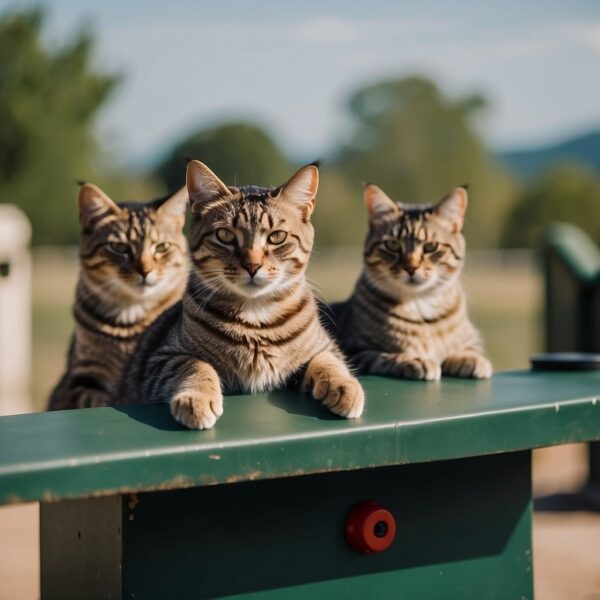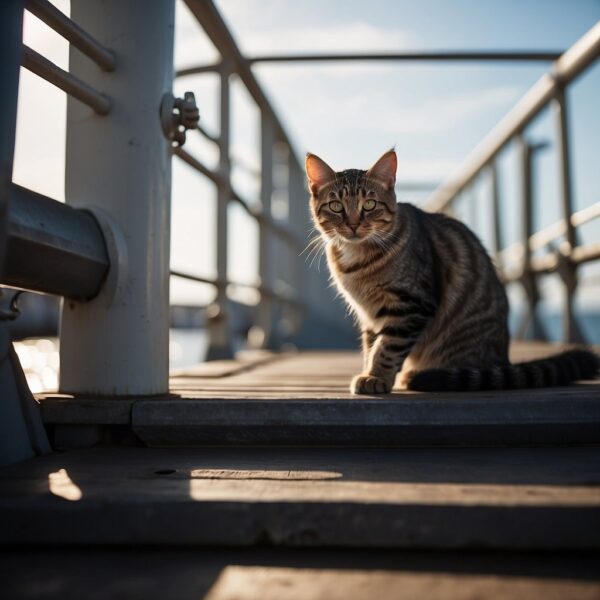
Role of Felines in Armed Forces
Throughout history, cats have served in the military. Cats have played more than the role of companions; they have served alongside humans in various capacities, including within the military. The bond between cats and military personnel has a storied past that spans different cultures and eras. These military cats have been present on the battlefields, on the decks of naval ships, and within the camps and barracks of soldiers around the world, providing not only comfort but also practical benefits to the armies with which they served.
In military history, cats have held critical roles ranging from morale boosters to tactical participants. They were valued aboard naval ships for their pest control abilities, protecting food supplies and vital equipment from rodents. On land, their heightened senses assisted troops by detecting dangers that were not easily perceived by humans. Moreover, cats have been recognized and honored for their service, reflecting their importance in military efforts. Their presence has also had significant psychological benefits, offering solace and a sense of normalcy to soldiers dealing with the stresses of military life.
Key Takeaways
- Cats have a longstanding and multifaceted involvement in military service.
- They have provided practical and psychological benefits to soldiers.
- Cats have been formally recognized for their contributions to military efforts.
Historical Role of Cats in Military
Throughout military history, cats have not only offered companionship to soldiers but also fulfilled practical roles, from pest control to psychological support, across different eras and both World Wars.

Ancient Military Campaigns
In Ancient Egypt, cats were revered and considered protectors. They were likely present during military campaigns as a symbol of good luck and to control pests that could otherwise damage supplies or spread disease. Beyond Egypt, histories suggest cats might have traveled with armies to perform similar roles, such as preventing grain stores from being consumed or contaminated by rodents. Historical accounts do not extensively document the presence of cats in ancient military campaigns compared to animals like horses and elephants which were used for transportation and in combat.
Cats in World War I
During World War I, cats served a significant role in the trenches of the Western Front. An estimated 500,000 cats were adopted by troops to control the rat population, which posed a severe problem due to the spread of disease and spoiling of food. Cats in this context were essential for maintaining healthier trench conditions. They also provided morale support for soldiers, easing the mental strain of war through their companionship.
Cats in World War II
The role of cats in World War II evolved further, cementing their status as mascots and companions. Cats served on warships and in field offices, mainly for pest control but also as cherished morale boosters for troops during the war’s pervasive hardship. A famous cat known as Crimean Tom is remembered for his service during the Siege of Sevastopol, where he helped British and French troops by leading them to hidden caches of food. Cats’ roles in military conflicts demonstrate their versatility and the unique comfort they provide to soldiers in times of stress.

Cats on Naval Ships
Felines have served on naval ships for centuries, playing roles as mascots for morale and expert mousers to protect provisions.
Cats as Mascots and Mousers
Historically, cats have been a common sight on naval ships, fulfilling practical and symbolic roles. Their primary role as mousers proved essential in controlling rodent populations, which could otherwise wreak havoc on a ship’s food supply and cause damage to ropes and woodwork. Moreover, cats served as unofficial mascots, providing companionship and comfort to sailors during long voyages. They were considered good luck charms and were embraced across various navies, including the Royal Navy and the RAF.
- Tiddles: A black cat who became the official captain’s cat aboard HMS Victorious and travelled thousands of miles during World War II.
- Simon: Awarded the Dickin Medal for bravery aboard HMS Amethyst during the Yangtze Incident, where he killed off a rat infestation despite being wounded.
Notable Naval Felines
Certain cats stand out in naval history for their service and the extraordinary tales that accompany them.
- Unsinkable Sam: Allegedly survived the sinking of three separate ships in WWII, becoming an iconic figure for resilience and survival.
- HMS Amethyst’s Simon: In addition to his mousing duties, he boosted the morale of the crew, receiving the highest honor for animal bravery in military conflict.
- Royal Navy’s Mascots: Cats were formally registered as members of the crew on British naval ships, a practice which persisted until the late 1970s.
Cats in Modern Military
In the contemporary setting, military cats have played pivotal roles ranging from morale boosters to skilled mousers protecting supplies.
Roles in Recent Conflicts
Cats continue to adopt crucial roles in military settings, especially in conflict zones. In Iraq, felines were companions to soldiers, offering comfort and a sense of family to units stationed far from home. A famous example is Private First Class Hammer, a cat that made an impact on troops’ lives by controlling the rodent population, thereby preserving the integrity of their food supplies. His presence not only increased morale among the troops but also exemplified the tradition of cats rendering important military service.
Military Bases and Cats Today
Nowadays, cats are omnipresent at military installations globally, providing a semblance of domesticity and normalcy. Organizations like Alley Cat Allies recognize the significance of these animals and have championed for their well-being and care, acknowledging their contribution to service members’ mental health. Cats today perform a similar function to their past counterparts; they nurture the morale of service members, strengthening their psychological resilience in the face of challenges on military bases.
Cats as Companions and Morale Boosters
During military conflicts, the presence of cats has often provided soldiers with comfort and a sense of familiarity. These feline companions have historically contributed to the relief of stress among troops. Their ability to offer love and affection made them invaluable to those serving away from home.
- Combatting Stress: Cats have an innate capacity for reducing anxiety among soldiers. Their presence helps in creating a calming atmosphere in otherwise stressful environments.
- Emotional Support: Bonding with cats offers soldiers a source of consistent emotional support, allowing them a momentary escape from the rigors of military life.
The role of cats as morale boosters cannot be overstated. In the trenches of WWI, they were more than just mousers; they also served as symbols of hope and resilience. Accounts of cats warn of impending dangers, as some were said to distinguish between the sounds of enemy and friendly aircraft, are particularly notable. Soldiers often shared their rations with their feline friends, reinforcing the bond between human and animal.
In modern times, even though cats may not serve in direct functional roles like in the past, their contribution to maintaining high morale remains recognized. They continue to be mascots and companions on military bases, serving as a living reminder that amidst conflict, kindness and companionship are enduring values.
Cats’ Sensory Contributions to Military Efforts
Cats have long been appreciated for their keen senses, and these qualities have found unique applications within military contexts. The feline auditory system is capable of detecting sounds at frequencies well beyond human capabilities. This has made them valuable in identifying the approach of enemy forces, such as German aircraft, during night-time operations.
Their sensitive sense of smell also aids in discerning traces of bombs or explosives, often before humans or mechanical sensors. Due to their acute olfactory abilities, cats could serve as early warning systems by reacting to the distinct chemical compounds found in explosive materials.
While not scientifically recognized as a sixth sense, cats’ perceived ability to detect changes in atmospheric pressure could inform soldiers of impending conditions that might impact military actions, such as bomber raids where weather plays a significant role.
To illustrate, the contributions can be summarized as follows:
| Sense | Military Application |
|---|---|
| Hearing | Detected the distant sounds of approaching enemy planes. |
| Smell | Identified the presence of explosives. |
| ‘Sixth Sense’ | Served as informal indicators of weather changes. |
Cats Honored for their Military Service
Throughout history, several cats have been officially recognized for their service in warfare, receiving prestigious awards and leaving a legacy that both military and history enthusiasts honor.
Awards and Recognitions
Dickin Medal: The most distinguished award a military animal can earn for service and valor is the Dickin Medal. It is often referred to as the “animal Victoria Cross,” and while many dogs, horses, and even pigeons have been recipients, the medal has been awarded to one cat named Simon. As a ship’s cat aboard HMS Amethyst, Simon received the medal for his courageous behavior during the Chinese Civil War.
- Unsinkable Sam: Initially serving on the German battleship Bismarck, this cat survived its sinking in 1941. He went on to serve on the HMS Cossack and survived another sinking. His service continued on the HMS Ark Royal, which also sank; Sam survived yet again, earning his nickname and becoming a legendary figure in military mascot lore.
- Mourka: This feline was tasked with delivering crucial messages during the Siege of Leningrad in World War II. While no formal awards are documented for Mourka’s service, his contributions as a service member were critical.
Legacy of Feline Heroes
Military mascots have been a source of morale for troops, and cats are no exception. Their presence has provided comfort in challenging environments and they are fondly remembered for their companionship and service. For instance, Princess Papule became the mascot of a United States Navy repair ship in World War II, epitomizing the endearing impact of cats in military history.
Furthermore, these heroic cats are celebrated posthumously, and their stories are preserved in military and naval museums, ensuring their legacies are not forgotten. For example, memorabilia related to Unsinkable Sam can be found on display, signifying the enduring bond between these feline heroes and the service members with whom they served.

Psychological Impact of Cats in Military Settings
The presence of cats in military settings has diverse impacts on the psychological well-being of soldiers. Cats provide companionship, often becoming cherished confidants in high-stress environments. Consistent interaction with feline companions can lead to significant stress relief for military personnel. Engaging with cats may trigger the release of calming hormones, like oxytocin, reducing feelings of anxiety and fostering emotional resilience.
Military personnel often experience heightened levels of stress; cats can offer a soothing presence that contributes to a sense of safety and comfort. The act of petting a cat can lead to lower blood pressure and can instigate a relaxation response, thus serving as a natural stress reliever.
Cats also play a role in boosting morale among the troops. Sharing moments of joy and amusement with cats can lighten the atmosphere and provide a brief escape from the rigors of military duties. Their playful antics can provide laughter and entertainment, which may strengthen the bond between service members and improve their cooperative spirit.
The affection demonstrated by cats is unconditional, reinforcing feelings of love and acceptance. This emotional support is crucial, as soldiers might be separated from their family and friends for extended periods.
A summary of the benefits of cats in military settings:
- Companionship: Offers loyal friendship and alleviates loneliness.
- Stress Relief: Reduces the physiological response to stress.
- Morale: Encourages a positive outlook and camaraderie among soldiers.
- Joy: Lightens moods with playful behavior.
- Safety & Comfort: Provides a comforting presence that promotes a sense of security.
- Love: Gives and inspires feelings of affection and care.
Logistics and Care of Military Cats
Proper logistics and care are crucial for the health and efficiency of cats serving in the military. These animals require specific attention to their diet, living conditions, and health to fulfill their roles effectively.
Feeding and Shelter
Military cats on ships and in barracks require a diet that meets their nutritional needs. Rations for these cats are often specially formulated to ensure they have the energy and health to perform their duties, which include pest control and morale boosting for the men. Shelters for cats must provide safety and comfort, regardless of the environment. On ships, cats have designated nesting areas that keep them secure even during rough seas.
- Daily Rations:
- Wet food: 2 cans
- Dry food: 1 cup
- Water: Constant access
- Shelter Specifications:
- Bedding: Soft, replaceable material
- Safety: Secure from equipment and heavy foot traffic
- Location: Quiet corners, away from direct engine noise
Veterinary Care and Quarantine
A medical officer typically oversees the health of military cats, providing regular check-ups and vaccinations. Cats are also subject to quarantine procedures when first brought on board or when illness is suspected, to prevent any spread of disease among the crew or the animal population. In cases where a cat falls sick, immediate care is administered, and isolation protocols are followed to maintain the wellbeing of all on the ship.
- Health Check-Up:
- Frequency: Bi-monthly examination
- Vaccinations: As per military veterinary guidelines
- Quarantine Measures:
- Duration: Minimum of two weeks for new arrivals
- Facilities: Isolated from general populace, with constant monitoring
Cats as Cultural Symbols in Military History
Throughout history, cats have been perennial fixtures in military settings, often adopted as military mascots. They are seen as carriers of good fortune, a superstition that has led superstitious sailors to view them as essential companions.
The presence of cats on naval ships was a common practice designed to control vermin populations. Still, a deeper bond formed between these feline mascots and their human counterparts, often considered a part of the crew and a welcome source of comfort during times of conflict.
Military units have historically utilized the imagery and attributes of cats in their military code names and insignia. Such symbols encapsulate the agility, independence, and stealth traits that align well with military values.
In warfare, cats’ perceived ability to sense impending dangers made them integral to maintaining morale. Their contributions span from ancient battles to modern conflict, where their roles as mascots provided a semblance of peace in dire situations.
The exceptional hearing and night vision of cats, coupled with their quiet and observant nature, have cemented their status within military circles as more than just mascots but as symbols of resilience and watchfulness.
| Era | Role of Cats |
|---|---|
| Ancient Times | Vermin control, omens of good or bad luck |
| World War I | Companions, symbols of hope |
| World War II | Mascots, represented in unit insignia |
| Modern Times | Mascots, comforters, featured in code names |
Case Studies of Feline Service
Throughout history, cats have served alongside military personnel, providing companionship, pest control, and even participating in wartime tactics. These case studies illustrate the varied roles cats have played in military history.
Famous Feline Soldiers
Able Seacat Simon is perhaps the most celebrated military cat, serving aboard HMS Amethyst during the Yangtze Incident in 1949. For his service, he received the prestigious Dickin Medal, honored for surviving injuries and continuing to perform his duties as a ship’s cat. His presence on the Amethyst during the shelling along the Yangtze River remains a testament to resilience.
Another distinguished military cat, Crimean Tom, assisted British troops during the Crimean War by leading them to a cache of food hidden beneath the rubble. Similarly, Unsinkable Sam became known for surviving the sinking of three separate ships during World War II.
Pooli, who served on the USS Fremont during World War II, was outfitted in a specially tailored uniform on her birthday each year to honor her service, which included surviving the invasion of Okinawa.
Cats in Special Operations
Cats were not only mascots but also participated in more covert roles. For instance, Mourka was tasked by the Russian army to carry messages during the siege of Stalingrad. Due to their agile and stealthy nature, cats like Mourka provided critical support at times when traditional methods of communication were compromised.
Private First Class Hammer became a heroic figure to the U.S. Army unit he joined in Iraq. His role in the storeroom chasing away pests was crucial in protecting the soldiers’ food supplies, thus showcasing a cat’s ability to contribute meaningfully to military life.
Frequently Asked Questions
Cats have offered various services throughout military history. They’ve played untraditional yet vital roles, from companionship to practical duties.
What roles have cats historically played in military operations?
Historically, cats have served as mousers, reducing the rodent population that could damage supplies and spread disease. They have also served as mascots and companions, boosting the morale of troops.
What types of military training involve the use of cats, if any?
There are no specific military training programs for cats since they mostly provided ancillary support in operations. Unlike dogs, cats do not typically undergo rigorous training for roles in the military.
How did cats contribute to World War 1?
During World War 1, cats were primarily used to control pests in the trenches and aboard ships. These duties helped prevent the spread of diseases carried by rodents.
Can service members keep cats on military bases or accommodations?
Policies on keeping cats on military bases or accommodations may vary. The introduction of the military’s pet transportation allowance, reflects an understanding of the importance of pets, including cats, to service members.
Do any navies currently employ cats for on-ship duties?
There are no formal programs where modern navies employ cats for on-ship duties. However, cats historically served as mousers on naval vessels and may still be found informally aboard some ships.
What are some notable names given to cats in the military?
Notable military felines include Unsinkable Sam, who survived three ship sinkings during World War 2, and Pooli, who served aboard a US Navy attack transport during the same war.